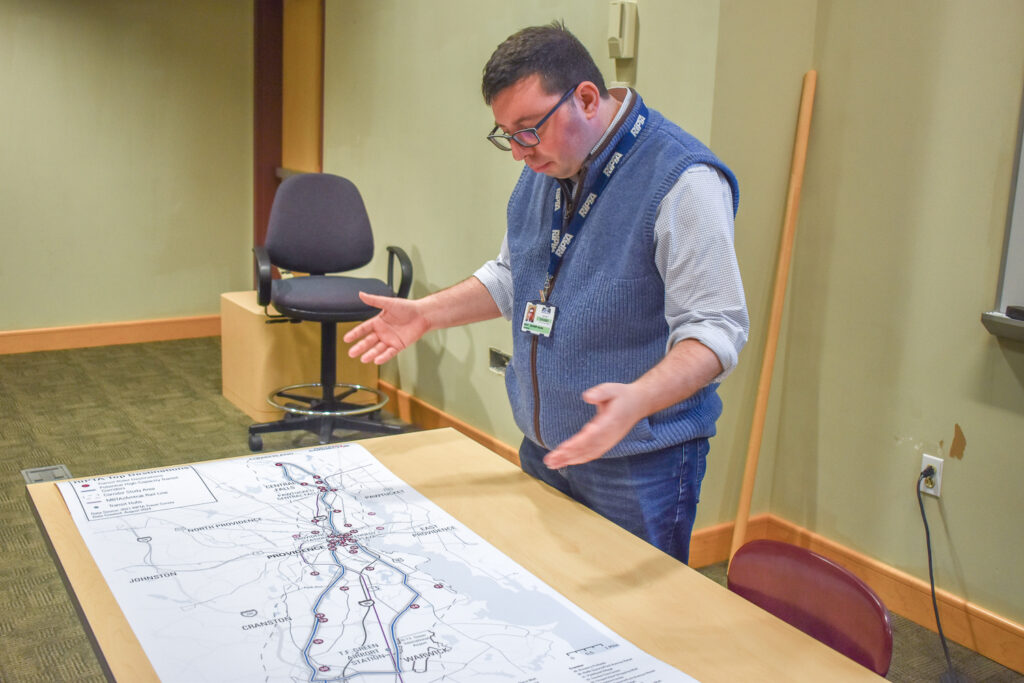Rhode Island Public Transit Authority Principal Planner Zachary Agush presents a map of the proposed Metro Connector lines at a public engagement session at CCRI’s Warwick campus on Sept. 30, 2024. (Christopher Shea/Rhode Island Current)
WARWICK — Half a dozen staffers from the Rhode Island Public Transit Authority (RIPTA) had enough snacks to welcome a busload of people to an engagement session on the fourth floor of the Community College of Rhode Island’s (CCRI) Knight Campus.
But only Chelsea Jimmins, 23, of West Warwick hopped off a bus for the meeting. Jimmins, who works at Walmart and doesn’t have a driver’s license, said they only found out about the meeting through social media and wanted to have a say on how public transportation should operate in the Ocean State — specifically to request RIPTA have more beach buses during the summer.
“I don’t care if I have to transfer between trains in Providence — I just want more options during the summer outside of having to deal with beach traffic,” Jimmins said.
That was sort of the point behind the meeting, which was to gather rider feedback as part of planning for a rapid bus or light rail service connecting densely populated communities in central Rhode Island and Blackstone Valley. Plans would link the corridor between Warwick at its southern end to Central Falls and possibly even Cumberland at its northern end.
The proposed “Metro Connector,” as the transit corridor would be called, is a core component of the state’s Transit Master Plan adopted in 2020, which envisions expanded and improved service, more accessibility and more frequent trips. For the past two weeks, RIPTA staff have been seeking rider feedback via a series of public meetings and an online survey as it considers potential stops and whether bus service or rail makes sense.
The survey runs through Monday, Oct. 7, and is funded through a $900,000 Rebuilding American Infrastructure with Sustainability and Equity (RAISE) grant from the U.S. Department of Transportation.
“It’s probably one the of the shinier projects of the master plan,” GrowSmart RI Deputy Director John Flaherty said in a phone interview. “This is a good one to lead with because it gets people really thinking about their use of transit — this is the kind of project that draws people in.”
RIPTA Principal Planner Zachary Agush said the agency has received feedback from about 600 people, mostly from conducting outreach in the field, and some from three prior public meetings in Pawtucket, West Warwick, and Providence held last week.
Agush said feedback has mostly questioned how RIPTA will overhaul the state’s transit system, along with comments in favor of an elevated rail system similar to Chicago.
“I’ll take the idea, but I don’t know how likely it is,” Agush said. “But it is an option we have to consider.”
The most common comment: Why didn’t RIPTA start this endeavor sooner? That’s because the RAISE grant wasn’t officially authorized until 2023, spokesperson Cristy Raposo Perry told Rhode Island Current.
“While many discretionary grant programs offer pre-award authority, which enables procurement to proceed and costs to be incurred prior to execution of a grant agreement, the RAISE program does not,” she said in an emailed statement.
An R-Line bus turns on to North Main Street in Providence on April 15, 2024. (Christopher Shea/Rhode Island Current)
Bus vs. rail
Bus rapid transit would be similar to the R-Line connecting Cranston, Providence and Pawtucket with RIPTA buses coming every 10 minutes. But it would include dedicated lanes that only buses go in — almost like a train running on rubber tires.
“It’s got better reliability and better trip speed because you’re not getting stuck in traffic,” Flaherty said.
Examples in the region include the Silver Line connecting Boston to Chelsea, Massachusetts, and the CTfastrak operating between Hartford and New Britain, Connecticut.
Flaherty said it’s also a likely cheaper choice compared to light rail, which would require significant time and construction.
Good for growth
One potential route would start at the Pawtucket/Central Falls line ending at CCRI’s Warwick Campus and the other would begin in downtown Providence finishing at Rhode Island T.F. Green International Airport.
“The fact that it goes through the absolute densest part of our state is an urban-defining feature,” Flaherty said.
He said a Metro Connector line could also bode well for the state’s goal to create more transit-oriented housing, which puts residents within a quarter mile of public transportation.
“That’s really the sweet spot,” he said.
Agush said the study’s focus on Rhode Island’s urban core was because of the cities’ ability to maintain density along former streetcar networks, Agush said.
“And that’s where a lot of RIPTA’s network stems from,” he said.
While riders like Jimmins might want to get to South County or Newport faster, the Metro Connector Online survey remains focused on Rhode Island’s urban core. Agush said places like Newport and Woonsocket won’t be ruled out in the future for “regional rapid transit” — which may not have the 10-minute frequency like the R-Line, but still would have a steady stream of buses throughout the day.
Agush said RIPTA won’t likely have final recommendations ready until summer 2025. From there, the agency’s Board of Directors will need to back whatever route RIPTA staff presents followed by local and state approvals.
“If everyone’s on the same page — then the conversation becomes converting these into proper projects,” Agush said.
RIPTA will hold its next public engagement meeting at the Rhode Island College Workforce Development Hub in Central Falls on Wednesday, Oct. 9, and one more in Cranston at a location and date still to be determined.
GET THE MORNING HEADLINES.

